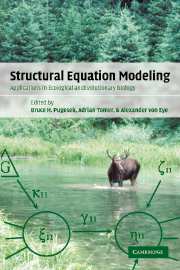11 results
Section 1 - Theory
-
- Book:
- Structural Equation Modeling
- Published online:
- 14 October 2009
- Print publication:
- 23 January 2003, pp 1-2
-
- Chapter
- Export citation

Structural Equation Modeling
- Applications in Ecological and Evolutionary Biology
-
- Published online:
- 14 October 2009
- Print publication:
- 23 January 2003
Section 3 - Computing
-
- Book:
- Structural Equation Modeling
- Published online:
- 14 October 2009
- Print publication:
- 23 January 2003, pp 353-354
-
- Chapter
- Export citation
Index
-
- Book:
- Structural Equation Modeling
- Published online:
- 14 October 2009
- Print publication:
- 23 January 2003, pp 392-409
-
- Chapter
- Export citation
4 - A short history of structural equation models
-
-
- Book:
- Structural Equation Modeling
- Published online:
- 14 October 2009
- Print publication:
- 23 January 2003, pp 85-124
-
- Chapter
- Export citation
Contents
-
- Book:
- Structural Equation Modeling
- Published online:
- 14 October 2009
- Print publication:
- 23 January 2003, pp vii-viii
-
- Chapter
- Export citation
Section 2 - Applications
-
- Book:
- Structural Equation Modeling
- Published online:
- 14 October 2009
- Print publication:
- 23 January 2003, pp 141-142
-
- Chapter
- Export citation
Preface
-
- Book:
- Structural Equation Modeling
- Published online:
- 14 October 2009
- Print publication:
- 23 January 2003, pp xi-xiv
-
- Chapter
- Export citation
Frontmatter
-
- Book:
- Structural Equation Modeling
- Published online:
- 14 October 2009
- Print publication:
- 23 January 2003, pp i-vi
-
- Chapter
- Export citation
5 - Guidelines for the implementation and publication of structural equation models
-
-
- Book:
- Structural Equation Modeling
- Published online:
- 14 October 2009
- Print publication:
- 23 January 2003, pp 125-140
-
- Chapter
- Export citation
List of contributors
-
- Book:
- Structural Equation Modeling
- Published online:
- 14 October 2009
- Print publication:
- 23 January 2003, pp ix-x
-
- Chapter
- Export citation



